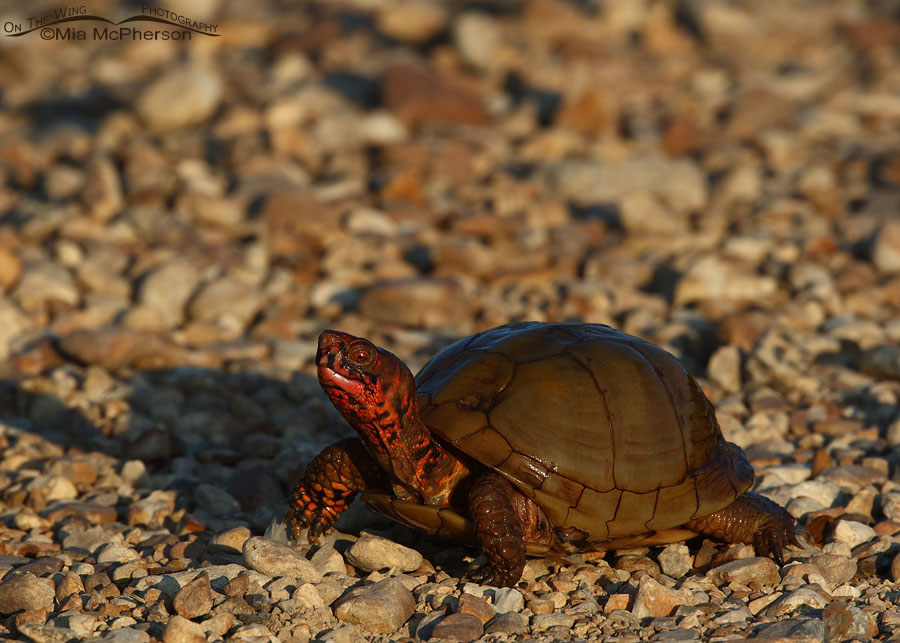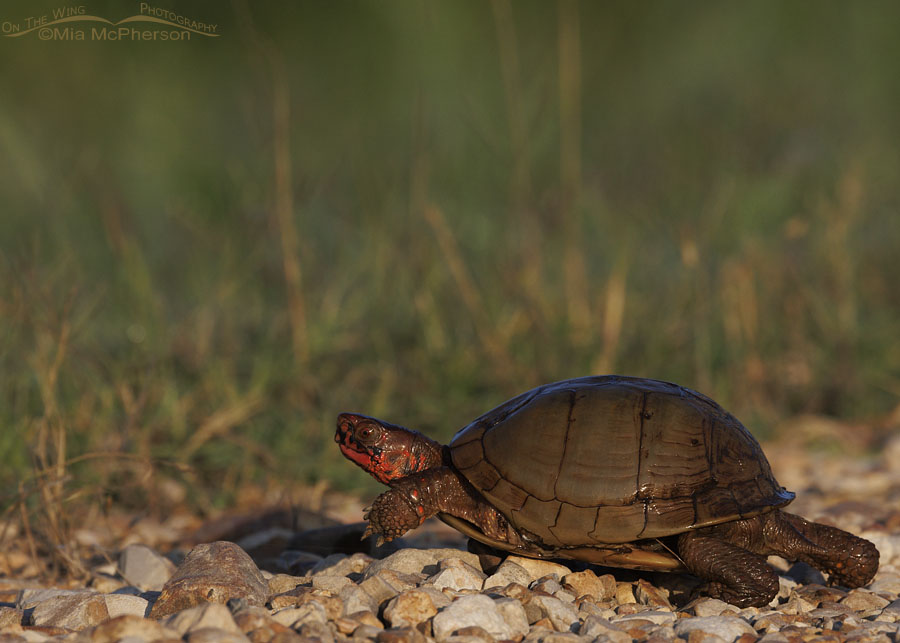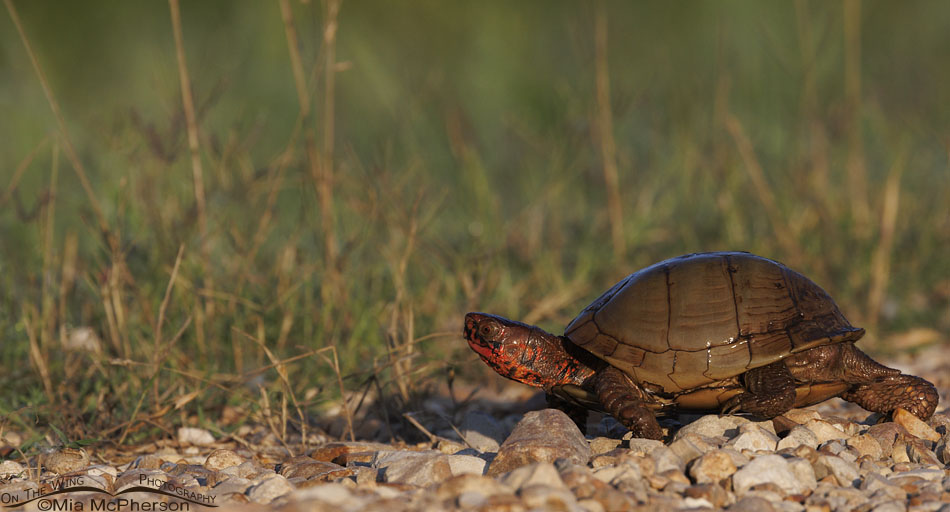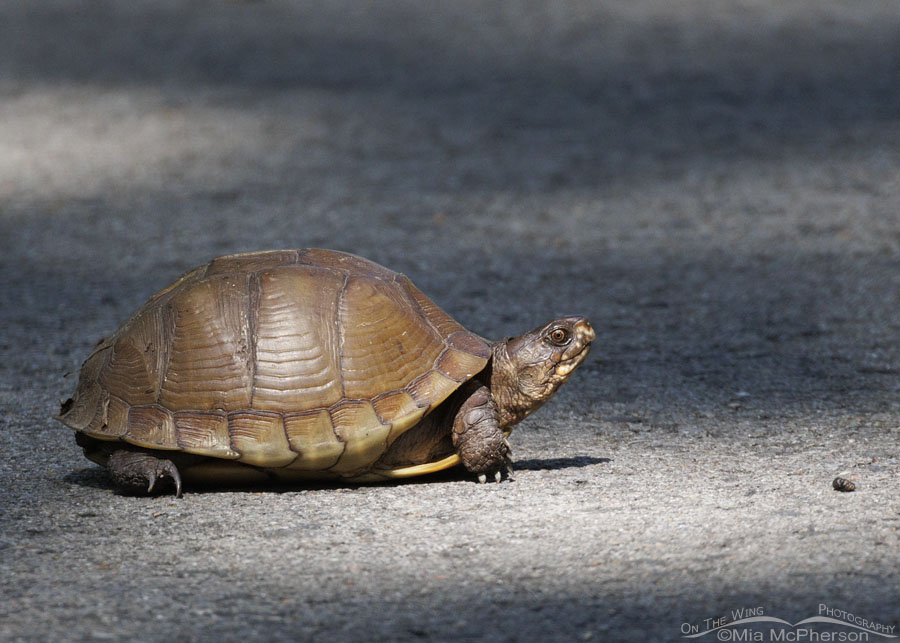This morning I am showcasing four Three-toed Box Turtle photos that I took while I visited Sequoyah National Wildlife Refuge in northeastern Oklahoma. As stunning as the views are there, my focus was on the birds and wildlife found at the refuge, including these box turtles.
 Three-toed Box Turtle glowing in morning light – Canon R7, f8, 1/1600, ISO 500, -0.7 EV, Canon RF 100-500mm at 500m, natural light
Three-toed Box Turtle glowing in morning light – Canon R7, f8, 1/1600, ISO 500, -0.7 EV, Canon RF 100-500mm at 500m, natural light
This was the most colorful Three-toed Box Turtle I photographed on my visits to the refuge. His red spots positively glowed in the early morning light. I jumped out of Steve Creek’s pickup to take this image and the two below it, so I could capture a low-angle perspective. My first couple of images were slightly blurry due to my excitement.
 Three-toed Box Turtle on the move – Canon R7, f8, 1/1600, ISO 500, -0.7 EV, Canon RF 100-500mm at 500m, natural light
Three-toed Box Turtle on the move – Canon R7, f8, 1/1600, ISO 500, -0.7 EV, Canon RF 100-500mm at 500m, natural light
Having this Three-toed Box Turtle in my viewfinder was a great treat for me because I don’t see box turtles in Utah.
Three-toed Box Turtles are named because they have three toes on their back feet. Box turtles are unique in that they can close their shells up completely. They can live as long as 50 years when they are kept as pets. My opinion on this matter is that unless the box turtles are unable to be released due to injuries, it is best to leave them in the wild.
 Three-toed Box Turtle at Sequoyah NWR – Canon R7, f8, 1/1600, ISO 640, -0.7 EV, Canon RF 100-500mm at 500m, natural light
Three-toed Box Turtle at Sequoyah NWR – Canon R7, f8, 1/1600, ISO 640, -0.7 EV, Canon RF 100-500mm at 500m, natural light
I loved seeing the box turtles at the refuge and wish I had seen more of them than I did. Seeing them in the wild brought me so much joy. I hope this particular turtle lives a long and healthy life.
 Three-toed Box Turtle in a natural spotlight – Canon R7, f11, 1/1000, ISO 2000, -0.3 EV, Canon RF 800m, natural light
Three-toed Box Turtle in a natural spotlight – Canon R7, f11, 1/1000, ISO 2000, -0.3 EV, Canon RF 800m, natural light
The male Three-toed Box Turtles display bright yellow, orange, and red spots on their heads, necks, and front legs. The females are duller, which is why I believe that this turtle, photographed a few days after the male mentioned above, was a female. She was crossing the road in dappled light, which gave my image a natural spotlight effect.
I know I have more photos of this species to share and will do so when I have the time. For now, I wanted to share these Three-toed Box Turtle photos today.
Life is good.
Mia
Click here to see my Three-toed Box Turtle gallery. I will be adding more images of this species as time allows.


What a pretty little fella! Love the coloring and the light!
Thank you. Both are beautiful and it is way too long since I have seen a turtle in the wild.
Mr. Box Turtle is quite the handsome fellow! He knows it too — looks like he’s smiling for your camera. It also looks like there might be something going on at the front of his shell. I hope it isn’t an injury or infection.
Ms. Box Turtle is more demure and just as photogenic, in my opinion. Your shot includes so much wonderful shell detail as well as her beautiful eye.